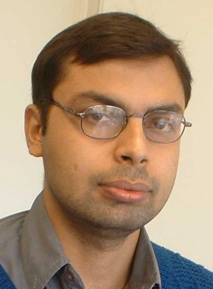Cavitation for Biomedical Applications
Promotion Date: 16 February 2006
| Cavitation is the formation of vapour bubbles in liquid when you reduce the normal pressure surrounding the liquid. They last for a very short period of time, in the order of hundredths of microseconds. Cavitation has been known since the last century, it plays a part in ship propellers, reducing the efficiency of the propulsion and even damaging the propeller. There is still no final solution for this problem, although they have found some get-arounds. In biomedical applications the cavitation principle is used for breaking kidney stones with pressure waves. (Shockwave lithotripsy). |
What was your thesis about?
Cavitation is the formation of vapour bubbles in liquid when you reduce the normal pressure surrounding the liquid. They last for a very short period of time, in the order of hundredths of microseconds. It makes it a phenomenon that is difficult to observe. We take photos of the different stages with a special high speed camera (stroboscopic imaging).
Cavitation has been known since the last century, it plays a part in ship propellers, reducing the efficiency of the propulsion and even damaging the propeller. There is still no final solution for this problem, although they have found some get-arounds.
In biomedical applications the cavitation principle is used for breaking kidney stones with pressure waves. (Shockwave lithotripsy). It is difficult to pinpoint what exactly happens in the procedure: is it the shockwave or the cavitation bubbles that occur when the pressure of the wave reduces that actually break the stones? However, the bubbles damage the tissue in the body, and that makes it important to study the phenomena. That was part of my thesis: how the bubble clusters behave at the surface of the stone.
Did you study this in a human body?
No, outside the body. We used marbles and steel stones of the same size of an average kidney stone. We found that the bubbles collapse simultaneously at the surface of the stone, whereas normally cavitation bubbles shrink individually. This gives an indication of the damage to the stone.
Is that the main conclusion of your thesis?
No, the lithotripsy (‘stone breaking’) is just one part of it. We also looked at how cavitation bubbles behave close to a layer of cells. The bubble then forms a jet towards the cell surface during the collapse. Then the liquid spreads out, causing a sheer on the cell membrane. This phenomenon could be used for putting drugs into a cell. This is called sonoporation.
I don’t understand how the drug is actually administered.
The drug is introduced into the body, either by mouth or injection. It circulates in the blood.
If you want to deliver this drug locally, you create the bubbles where you want it and the drug enters the damaged cell.
Could this be the answer to the treatment of a localized cancer?
I won’t go that far that fast. There is still a lot to be done before you could actually do this.
But it is the direction we are heading for; opening localized cells and let the drug enter through the damaged cell membrane. But I would go more for in vitro techniques, where you introduce genes into cells rather than cancer treatment. The latter is a dangerous thing to do, because also some cancer cells might peel off and cause metastases in the body. If we have more control it could be a future possibility.
Where are you from?
I am from India.
How did you come to do a PhD here?
The bubbles brought me here. In my bachelors project I looked at bubbles created by ultrasound. I saw publications of Professor Detlef Lohse’s group and the group of Professor Andrea Properetti . They are both quite famous in the field of bubbles. I wrote to professor Properetti and I was accepted for this project.
And what do you think of your (nearly) four year period here?
I like the university very much. The climate is doable. The labs are better equipped to what I was used to before and I enjoyed working with my colleagues. I also had a lot of support from Claus Dieter Ohl he is part of the reason why I could do my work so fast.
However, I had some problems with the bureaucracy, it was tough getting the paper work done. When I came here my name was misspelled (in India my birth certificate was written by hand and here they could not read it), so my official documents had the name Arora and here I was known as Arore. It took two years to sort out this problem; and it had to be properly sorted out because I wanted to go abroad. I had to cancel a trip to UK because of this.
I had my share of troubles. Otherwise I enjoyed my stay.
What are you going to do next?
I am staying for another 6 months, writing articles and there is still some additional work to do. I want to focus on launching bubbles with particles into tissue. After that I would like to go to the UK, my girlfriend already has a job there and will start in August in London. But in the long run I want to go back to India. It is my home country and I want to see that science gets to the same level as here.

